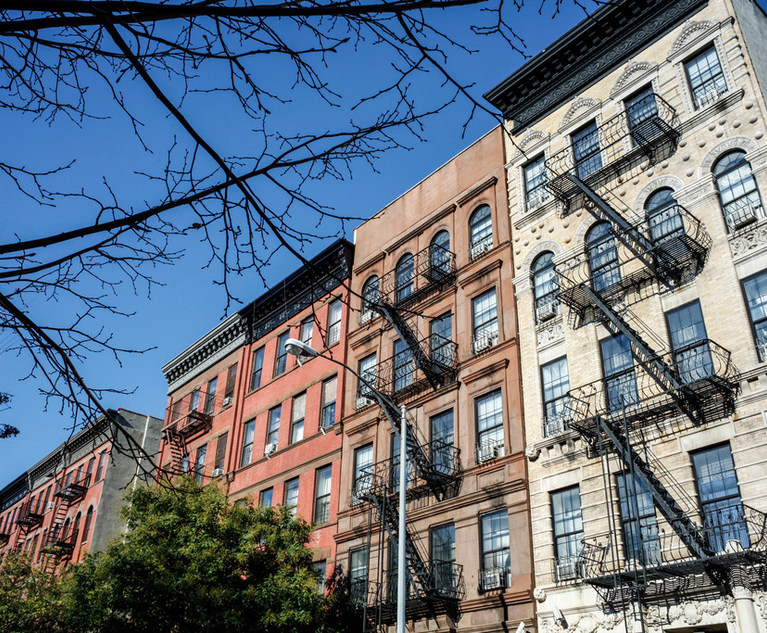Co-op and Condo RPTL 467-a Tax Abatement and the Primary Resident Requirement
The legislature appears to be satisfied with the DOF's application of RPTL 467-a's Primary Resident Tax Abatement to individuals (and statutorily mandated limited trusts), and that only one of several owners of a single cooperative or condominium must meet the primary resident requirement to qualify for the tax abatement. This is a commonsense approach that considers the realities of the current transitional world.
July 28, 2022 at 11:00 AM
9 minute read
 For several decades, many cooperatives and condominiums in New York City have benefitted from a tax abatement program under Real Property Tax Law §467-a. The amount of the abatement varies from 17.5% to 28.1% and depends on the average assessed value of units in the building (see Tax Equity Now NY LLC v. City of New York, 182 A.D.3d 148, 156 [1st Dep't 2020], appeal dismissed 35 N.Y. 1079 [2020], lv. granted 28 N.Y.3d 906 [2022]). RPTL §467-a's tax abatement should be called the Primary Resident Tax Abatement because, under its current form, an essential criterion for eligibility is the primary resident requirement (see RPTL 467-a[2][a]). This requirement raises an interesting question in the scenario where a condominium or cooperative unit has more than one "owner." That is, whether all unit owners must meet the primary resident requirement to qualify for the tax abatement. The statute does not provide an explicit answer to the question. However, the rules promulgated by the agency responsible for administering the tax abatement, the New York City Department of Finance (DOF), does provide a definitive answer. As fully explained below, the answer is that only one of several owners of a single cooperative or condominium must satisfy the primary resident requirement.
For several decades, many cooperatives and condominiums in New York City have benefitted from a tax abatement program under Real Property Tax Law §467-a. The amount of the abatement varies from 17.5% to 28.1% and depends on the average assessed value of units in the building (see Tax Equity Now NY LLC v. City of New York, 182 A.D.3d 148, 156 [1st Dep't 2020], appeal dismissed 35 N.Y. 1079 [2020], lv. granted 28 N.Y.3d 906 [2022]). RPTL §467-a's tax abatement should be called the Primary Resident Tax Abatement because, under its current form, an essential criterion for eligibility is the primary resident requirement (see RPTL 467-a[2][a]). This requirement raises an interesting question in the scenario where a condominium or cooperative unit has more than one "owner." That is, whether all unit owners must meet the primary resident requirement to qualify for the tax abatement. The statute does not provide an explicit answer to the question. However, the rules promulgated by the agency responsible for administering the tax abatement, the New York City Department of Finance (DOF), does provide a definitive answer. As fully explained below, the answer is that only one of several owners of a single cooperative or condominium must satisfy the primary resident requirement.
A review of the history of RPTL 467-a is instructive in understanding the meaning of the term "owner" within the context of the primary resident requirement. The genesis of RPTL 467-a stems from a study commissioned by the City in the 1990s, which concluded that the tax rate for condominiums and cooperative in New York City was substantially higher than for Class one properties (primarily one-, two-, and three-family residential real property), which are taxed at a significantly lower rate (see Memo in Support A-10588-A, NY Assembly, 1996 NY Session Laws at 2233 [McKinney 1996]). In 1996, to address this disparity, the state legislature passed RPTL 467-a which provided a partial real estate tax abatement to condominium and cooperative unit owners of three or fewer units in the same development. The initial version of RPTL 467-a was very broad: The 1996 version did not explicitly prohibit corporate entities from receiving the abatement; nor did it contain a provision limiting the abatement to units that were the primary residence of the owner.
RPTL 467-a, however, was amended in January 2013 primarily to add the requirement that the unit must be the primary residence of a unit owner (see RPTL 467-a[2][a]-[b]) and made the requirement retroactive to the 2012-2013 tax year. The 2013 amendment did not define what the term "primary residence of such unit owner" meant. However, it was generally understood that the motivation for adding the "primary residence" requirement was to address the fact that a significant number of beneficiaries from the 1996 statute were not owner-occupants of units but investors who were not the purported recipients of the abatement.
This content has been archived. It is available through our partners, LexisNexis® and Bloomberg Law.
To view this content, please continue to their sites.
Not a Lexis Subscriber?
Subscribe Now
Not a Bloomberg Law Subscriber?
Subscribe Now
NOT FOR REPRINT
© 2025 ALM Global, LLC, All Rights Reserved. Request academic re-use from www.copyright.com. All other uses, submit a request to [email protected]. For more information visit Asset & Logo Licensing.
You Might Like
View All
After Solving Problems for Presidents, Ron Klain Now Applying Legal Prowess to Helping Airbnb Overturn NYC Ban
7 minute read
This Week in Scott Mollen’s Realty Law Digest: Constructive Trust Claim; Succession Rights; Tenant ‘Blacklisting Law’

Here’s Looking at You, Starwood: A Piercing the Corporate Veil Story?
7 minute readTrending Stories
- 1AstraZeneca Files Flurry of Lawsuits to Protect Cancer Treatment Drug
- 2American Airlines Legal Chief Departs for Warner Bros. Discovery
- 3New Montgomery Bar President Aims to Boost Lawyer Referral Service
- 4Deadline Extended for Southeastern Legal Awards
- 5Church of Scientology Set to Depose Phila. Attorney in Sexual Abuse Case
Who Got The Work
Michael G. Bongiorno, Andrew Scott Dulberg and Elizabeth E. Driscoll from Wilmer Cutler Pickering Hale and Dorr have stepped in to represent Symbotic Inc., an A.I.-enabled technology platform that focuses on increasing supply chain efficiency, and other defendants in a pending shareholder derivative lawsuit. The case, filed Oct. 2 in Massachusetts District Court by the Brown Law Firm on behalf of Stephen Austen, accuses certain officers and directors of misleading investors in regard to Symbotic's potential for margin growth by failing to disclose that the company was not equipped to timely deploy its systems or manage expenses through project delays. The case, assigned to U.S. District Judge Nathaniel M. Gorton, is 1:24-cv-12522, Austen v. Cohen et al.
Who Got The Work
Edmund Polubinski and Marie Killmond of Davis Polk & Wardwell have entered appearances for data platform software development company MongoDB and other defendants in a pending shareholder derivative lawsuit. The action, filed Oct. 7 in New York Southern District Court by the Brown Law Firm, accuses the company's directors and/or officers of falsely expressing confidence in the company’s restructuring of its sales incentive plan and downplaying the severity of decreases in its upfront commitments. The case is 1:24-cv-07594, Roy v. Ittycheria et al.
Who Got The Work
Amy O. Bruchs and Kurt F. Ellison of Michael Best & Friedrich have entered appearances for Epic Systems Corp. in a pending employment discrimination lawsuit. The suit was filed Sept. 7 in Wisconsin Western District Court by Levine Eisberner LLC and Siri & Glimstad on behalf of a project manager who claims that he was wrongfully terminated after applying for a religious exemption to the defendant's COVID-19 vaccine mandate. The case, assigned to U.S. Magistrate Judge Anita Marie Boor, is 3:24-cv-00630, Secker, Nathan v. Epic Systems Corporation.
Who Got The Work
David X. Sullivan, Thomas J. Finn and Gregory A. Hall from McCarter & English have entered appearances for Sunrun Installation Services in a pending civil rights lawsuit. The complaint was filed Sept. 4 in Connecticut District Court by attorney Robert M. Berke on behalf of former employee George Edward Steins, who was arrested and charged with employing an unregistered home improvement salesperson. The complaint alleges that had Sunrun informed the Connecticut Department of Consumer Protection that the plaintiff's employment had ended in 2017 and that he no longer held Sunrun's home improvement contractor license, he would not have been hit with charges, which were dismissed in May 2024. The case, assigned to U.S. District Judge Jeffrey A. Meyer, is 3:24-cv-01423, Steins v. Sunrun, Inc. et al.
Who Got The Work
Greenberg Traurig shareholder Joshua L. Raskin has entered an appearance for boohoo.com UK Ltd. in a pending patent infringement lawsuit. The suit, filed Sept. 3 in Texas Eastern District Court by Rozier Hardt McDonough on behalf of Alto Dynamics, asserts five patents related to an online shopping platform. The case, assigned to U.S. District Judge Rodney Gilstrap, is 2:24-cv-00719, Alto Dynamics, LLC v. boohoo.com UK Limited.
Featured Firms
Law Offices of Gary Martin Hays & Associates, P.C.
(470) 294-1674
Law Offices of Mark E. Salomone
(857) 444-6468
Smith & Hassler
(713) 739-1250







